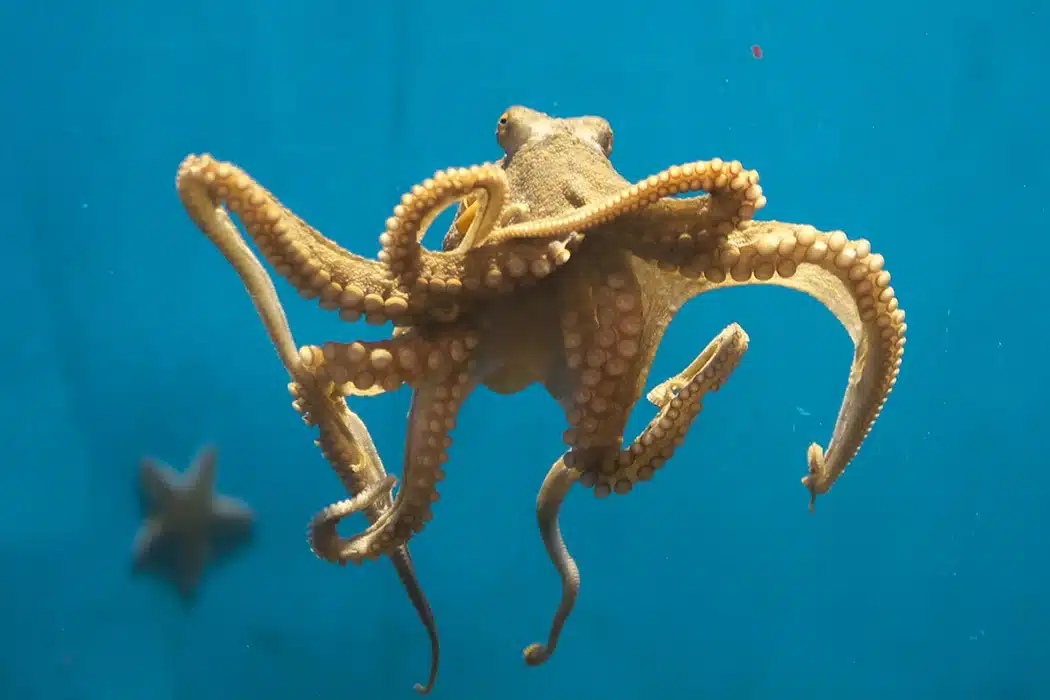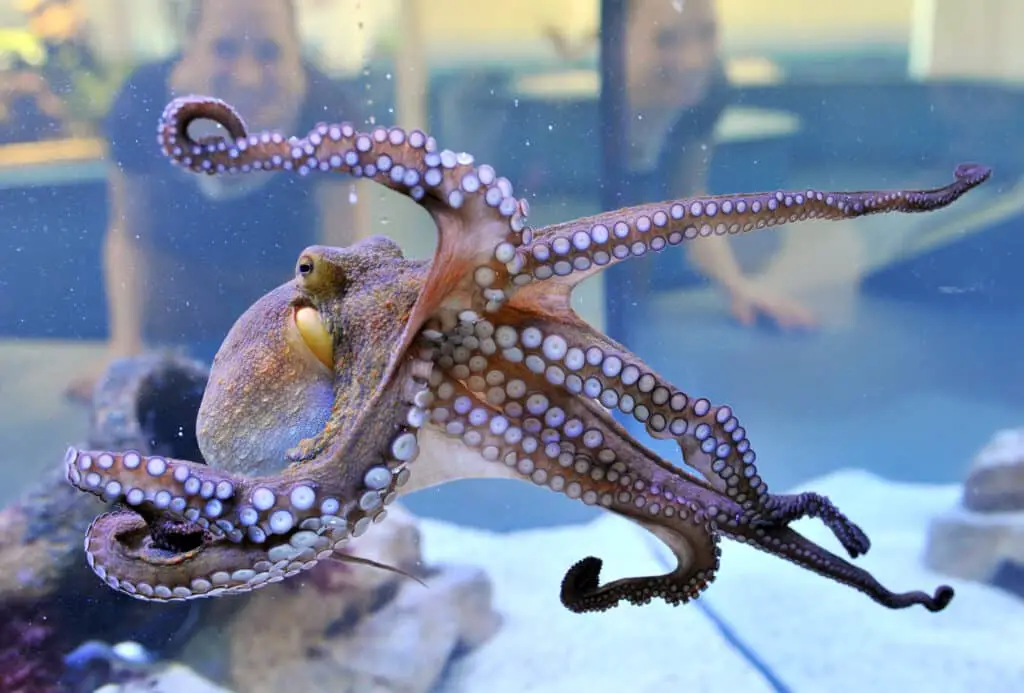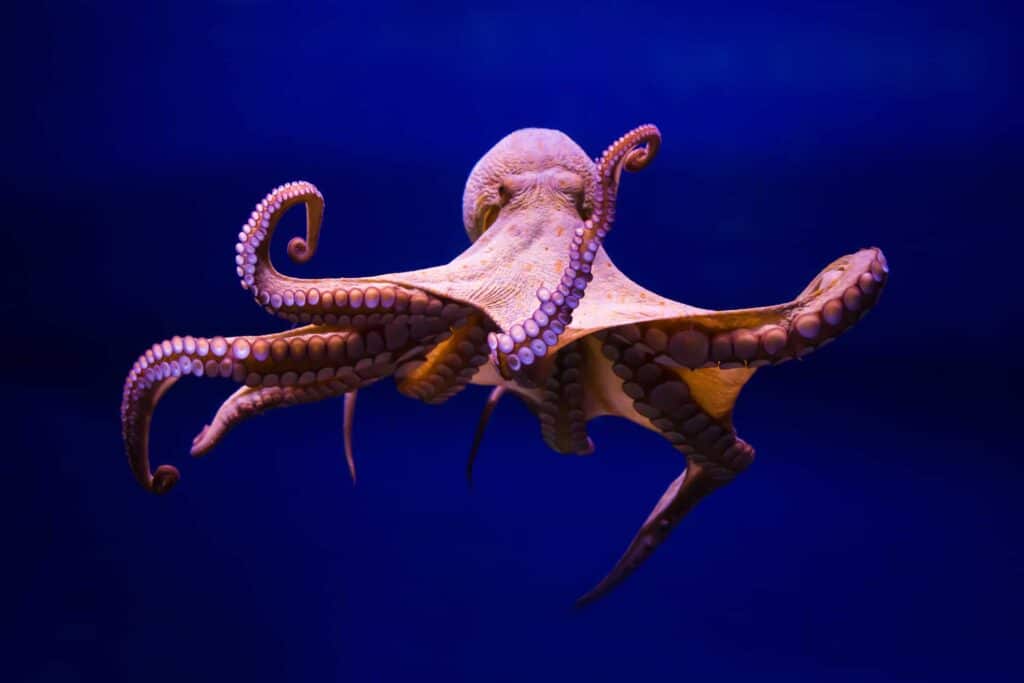Are Octopus Endangered

Introduction
Are Octopus Endangered: Octopuses, with their enigmatic intelligence and remarkable adaptability, have long captured the fascination of scientists and enthusiasts alike. The world’s oceans, where these creatures predominantly reside, have been undergoing profound alterations due to various anthropogenic factors, including overfishing, habitat destruction, climate change, and pollution.
In this exploration of the octopus’s conservation status, we delve into the multifaceted issues surrounding their survival. Octopuses play vital roles in marine food webs, serving as both predator and prey. Understanding their population dynamics and vulnerabilities is crucial not only for the octopuses themselves but also for the broader health of our oceans.
We’ll examine the challenges octopuses face, including the illegal trade in these fascinating creatures for the pet trade and culinary markets, which further exacerbate their vulnerability. Additionally, we’ll investigate ongoing research efforts and conservation initiatives aimed at protecting these elusive cephalopods.
Ultimately, the question of whether octopuses are endangered is a complex one, necessitating a comprehensive analysis of their biology, ecology, and the threats they face. Join us on this journey as we unravel the mysteries surrounding the conservation status of octopuses and the implications for the marine world.

Why are octopus endangered?
Studies show that octopus populations have been decreasing due to overfishing and the destruction of their habitats as well. Octopuses face endangerment primarily due to a combination of human-driven factors and environmental changes. Here are some key reasons why octopuses are endangered:
- Overfishing: Octopuses are sought after in the global seafood industry for their culinary value. The demand for octopus as a delicacy has led to overfishing in many regions, depleting their populations. Without effective regulations and sustainable fishing practices, this pressure continues to threaten their numbers.
- Habitat Destruction: Human activities, such as bottom trawling and seabed mining, can damage octopus habitats like coral reefs and rocky outcrops. The destruction of these critical environments reduces the availability of suitable homes and hiding places for octopuses.
- Climate Change: Rising ocean temperatures and ocean acidification, both consequences of climate change, can impact the availability of prey species for octopuses. Changes in ocean currents and temperatures can also disrupt the ecosystems where octopuses thrive.
- Pollution: Pollution from agricultural runoff, industrial discharge, and plastic waste can contaminate octopus habitats. Chemical pollutants can harm octopuses directly or indirectly by affecting their prey.
- Illegal Trade: Octopuses are sometimes captured for the pet trade or sold as curiosities. The illegal trade can deplete populations, particularly when collectors target specific species or individuals.
- Lack of Data: Limited knowledge about octopus populations and their life cycles makes it challenging to implement effective conservation measures. Research into octopus biology and ecology is essential for their protection.
- Lack of Regulation: In some regions, there is inadequate regulation of octopus fishing and conservation efforts. Strengthening international and regional agreements and enforcement can help protect these creatures.
Are octopus overfished?
The supply of octopus has been constrained by overfishing in many key fisheries and proponents of farming suggest human-induced culturing could help restock natural populations.
Octopuses are remarkable creatures inhabiting the world’s oceans, known for their intelligence and unique biology. However, concerns have risen about the sustainability of octopus fisheries, leading to questions about whether octopuses are being overfished.
Octopus populations face several threats due to human activities. Overfishing is a significant concern, driven by increasing global demand for their meat and the lucrative market for their unique, versatile ink. Octopus populations cannot reproduce as rapidly as some other seafood species, making them vulnerable to overharvesting. Octopuses have complex life cycles and specific habitat requirements, making them susceptible to habitat destruction from fishing practices such as bottom trawling.
Insufficient regulation and enforcement in many regions exacerbate the problem. Weak management measures and lack of data on octopus populations make it challenging to implement sustainable fishing practices effectively.
To address these concerns, it is crucial for governments, fisheries management organisations, and the seafood industry to collaborate on implementing sustainable fishing practices, setting catch limits, and protecting critical octopus habitats. Consumer awareness and responsible seafood choices can also play a role in mitigating the overfishing of octopuses.
Is it sustainable to eat octopus?
Some inshore octopus fisheries are sustainable and have a moderate impact on the environment, but most octopus fisheries, especially those offshore, exploit already low stocks, harm habitat and have high bycatch. Populations in Mauritania and Vietnam are in poor shape.
The sustainability of consuming octopus is a complex issue influenced by various factors, including fishing practices, population dynamics, and ecological impact.
Octopus is a popular seafood choice worldwide, known for its unique texture and flavour. However, the sustainability of octopus consumption varies depending on the source and methods of harvesting.
One of the main concerns is overfishing. Octopus populations are sensitive to overexploitation due to their relatively slow growth and reproduction rates. Many octopus species are also caught incidentally as bycatch in certain fishing practices, further threatening their populations.
To make octopus consumption more sustainable, it is essential to prioritize responsible fishing methods. Selective fishing techniques, such as trap or pot fishing, can reduce bycatch and minimize damage to the ocean floor compared to methods like bottom trawling. Additionally, implementing catch limits and seasonal closures can help protect octopus stocks and allow them to replenish.
Consumer awareness and choice also play a role in sustainability. People can opt for sustainably sourced octopus, look for certifications like Marine Stewardship Council (MSC), and support fisheries that adhere to sustainable practices.
The sustainability of eating octopus depends on responsible fishing practices, proper management, and informed consumer choices. By addressing these factors, we can strive to enjoy octopus as a seafood option without depleting their populations or harming the marine environment.
What types of octopus are endangered?
The two species of endangered octopi are the Cirroctopus hochbergi and the Opisthoteuthis mero. The critically endangered species of octopus, meaning that it is at the highest risk of extinction, is the Opisthoteuthis chathamensis.
Several species of octopus are facing endangerment due to various environmental threats and human activities. One such species is the Hawaiian day octopus (Octopus cyanea), which inhabits the coral reefs of the Hawaiian Islands. These intelligent creatures are vulnerable to overfishing, habitat destruction, and pollution. Their populations are dwindling as a result.
Another endangered octopus is the giant Pacific octopus (Enteroctopus dofleini), which is the largest known octopus species. Found along the coast of North America, from California to Alaska, these fascinating creatures face risks from commercial fishing practices and habitat degradation. Their slow reproductive rate makes them particularly susceptible to population declines.
The common octopus (Octopus vulgaris), found in various marine environments around the world, is also under threat. Overfishing and habitat destruction in coastal areas are primary factors contributing to their endangerment.
The shallow-water pygmy octopus (Octopus joubini) is experiencing declines in its population. Native to the Caribbean Sea, this small octopus species is impacted by habitat degradation, pollution, and potential overharvesting.
Efforts to protect these endangered octopus species include establishing marine protected areas, regulating fishing practices, and raising public awareness about the importance of preserving their habitats. Conservation measures are crucial to ensure the survival of these remarkable marine creatures for future generations.
What happens to an octopus when it is threatened?
Octopuses use several different strategies to evade predators—they camouflage themselves by quickly changing their skin color, they make colorful displays or eject ink to startle or confuse potential predators, they squeeze into small crevices to escape, and they quickly propel themselves through water.
When an octopus perceives a threat, it initiates a complex series of defense mechanisms tailored to its environment. The primary response involves its remarkable ability to rapidly change color and texture, allowing it to blend seamlessly with its surroundings. This process, known as chromatophore expansion, is facilitated by specialized pigment cells in the octopus’s skin.
Simultaneously, the octopus may alter the shape of its body, using muscular contractions to mimic objects like rocks or coral. This mimicry provides effective camouflage, making it exceedingly difficult for predators to detect the octopus.
In addition to its visual adaptations, an octopus can expel a cloud of ink from a specialized gland near its siphon. This ink serves as a smokescreen, obscuring the predator’s vision and allowing the octopus a crucial moment to escape. The ink is a mixture of melanin, which darkens the surrounding water, and mucus, creating a disorienting cloud.
Further, the octopus may engage in evasive maneuvers, utilizing its jet propulsion system. By forcefully expelling water from its mantle cavity through the siphon, the octopus can swiftly propel itself away from danger.
In extreme cases, when cornered or unable to escape, some species of octopus resort to employing venomous bites as a last line of defense. While this is a rare occurrence and varies by species, it underscores the array of strategies these remarkable creatures employ to ensure their survival in the face of imminent threats.
Which octopus species are considered endangered?
Several octopus species are considered endangered due to various environmental pressures and human activities. One such species is the Common Octopus (Octopus vulgaris), which is found in coastal waters worldwide. Overfishing and habitat degradation are primary threats to this species, leading to population declines in many regions.
The Hawaiian Day Octopus (Octopus cyanea), native to the coral reefs of Hawaii, is also endangered. These intelligent creatures face challenges from habitat destruction, pollution, and overfishing. Their slow reproduction rates make them particularly susceptible to population declines.
The Giant Pacific Octopus (Enteroctopus dofleini), the largest known octopus species, inhabits the waters along the coast of North America. It is also considered endangered due to commercial fishing practices and habitat degradation.
Conservation efforts are crucial to protect these endangered octopus species. Implementing measures like marine protected areas, regulating fishing practices, and raising public awareness about their importance in marine ecosystems are essential steps toward ensuring their survival. These remarkable creatures play vital roles in ocean ecosystems, and safeguarding their populations is vital for the overall health of marine environments.
What are the primary threats to octopus populations?
Octopus populations face several significant threats, primarily driven by human activities and environmental changes. One of the foremost concerns is overfishing. Many octopus species are targeted for their culinary value, as they are a popular seafood delicacy in various parts of the world. Overexploitation can lead to rapid declines in octopus populations, impacting marine ecosystems.
Habitat destruction and degradation pose another critical threat. Coastal development, destructive fishing practices, and pollution can disrupt the delicate balance of marine environments where octopuses reside. Coral reefs, which are essential habitats for numerous octopus species, are particularly vulnerable to degradation.
Climate change is also a growing concern. Rising ocean temperatures, ocean acidification, and changing currents can alter the habitats and food availability for octopuses, potentially affecting their reproduction and survival rates.
Pollution, including plastics and chemical contaminants, can have detrimental effects on octopus populations. Ingestion of plastic debris or exposure to pollutants can lead to health issues and reproductive problems.
Lastly, incidental capture in fishing gear, known as bycatch, is a significant threat to octopuses. Even if not directly targeted, octopuses can be inadvertently caught in nets or traps set for other species.
Addressing these threats requires a multi-faceted approach, including sustainable fisheries management, habitat protection, pollution reduction, and efforts to mitigate the impacts of climate change. Conservation measures are essential to ensure the long-term survival of these fascinating marine creatures.
Are there regulations in place to protect octopus populations?
Regulations aimed at protecting octopus populations vary by region and depend on the specific octopus species and the local fishing industry’s practices. While there is no single global framework for octopus conservation, many countries and regional fisheries management organizations have implemented measures to safeguard these cephalopods.
1. Catch Limits: Some regions have set catch limits to control the amount of octopus that can be harvested annually. These limits help prevent overfishing and ensure sustainable populations.
2. Size Restrictions: Regulations often include size limits to protect juvenile octopuses. By allowing octopuses to reach maturity before being harvested, these rules contribute to population sustainability.
3. Seasonal Closures: Seasonal closures during octopus breeding and spawning periods can protect critical stages in their life cycle and reduce fishing pressure during vulnerable times.
4. Fishing Gear Restrictions: Some areas restrict the types of fishing gear that can be used to target octopuses. For instance, banning destructive practices like bottom trawling can minimize habitat damage and bycatch.
5. Data Collection: Many fisheries require data collection on octopus catches and population assessments to inform management decisions and ensure compliance with regulations.
6. Marine Protected Areas (MPAs): Establishing MPAs can provide sanctuaries where octopus populations can thrive without fishing pressure, contributing to their conservation.
It’s essential for local governments, fishing industries, and conservation organizations to work together to enforce and adapt these regulations as needed to ensure the long-term sustainability of octopus populations. Public awareness and consumer choices can also play a role in supporting these conservation efforts.

Conclusion
The status of octopuses in our oceans is a matter of growing concern. While they are not universally categorized as endangered, several species are facing significant threats. The culmination of overfishing, habitat degradation, climate change, and pollution poses a complex challenge for octopus populations.
The importance of octopuses within marine ecosystems cannot be overstated. Their role as both predators and prey contributes to the delicate balance of the underwater world. Any disruption in their populations could have cascading effects, impacting not only marine life but also the livelihoods of communities dependent on fisheries.
Conservation efforts are underway, focusing on better understanding octopus biology and ecology, establishing protected areas, implementing sustainable fishing practices, and combating illegal trade. These initiatives provide hope for the preservation of these remarkable creatures.
However, the road ahead is fraught with uncertainties, as climate change continues to alter oceanic conditions and human activities persistently encroach upon marine habitats. Vigilance and concerted action are needed to ensure the long-term survival of octopuses and the health of our oceans.
In our quest to protect octopuses, we must also recognize the broader significance of their conservation – a symbol of our commitment to safeguarding the intricate web of life that thrives beneath the waves. The fate of octopuses is intertwined with the future of our oceans, and it is a responsibility we must not take lightly.



